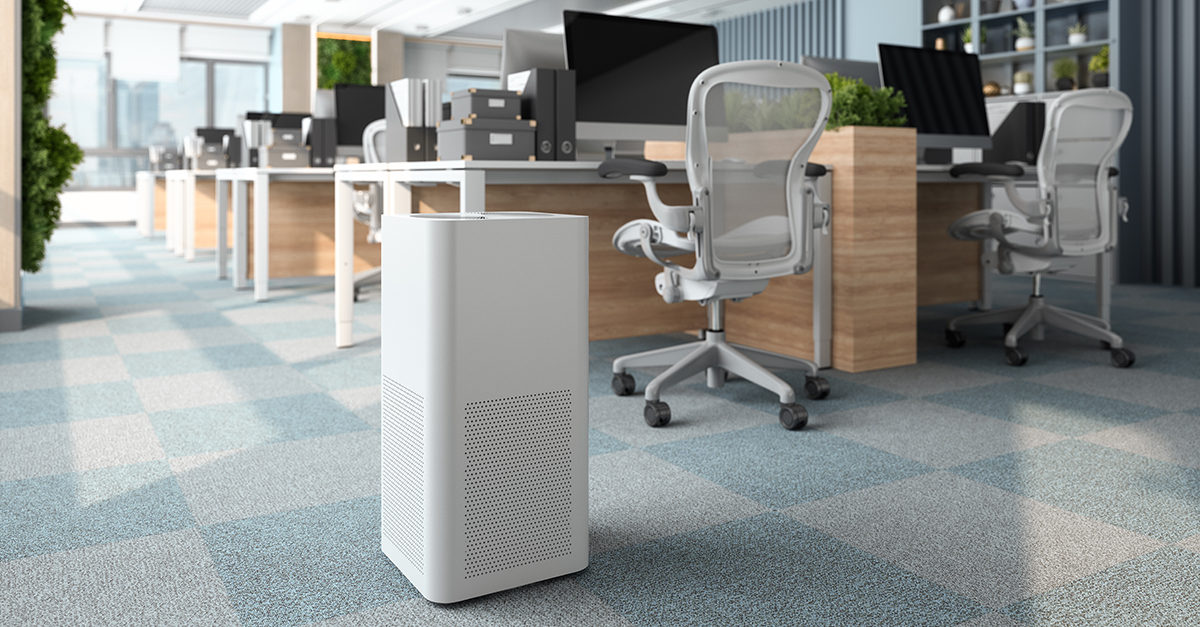Since the COVID-19 pandemic, indoor air quality (IAQ) and its importance in maintaining a clean, healthy environment have gained a lot more attention. This focus is long overdue, considering access to good IAQ should be as unalienable a right as uncontaminated drinking water.
While currently there is no universal standard for what constitutes optimal IAQ, there are several straightforward, quick, and relatively inexpensive steps you can take to ensure that the air in your facility is safer and healthier. When practiced together, these steps can provide layered protection against volatile organic compounds (VOCs) and other hazards that create unhealthy indoor air.
Keep up with cleaning
First, schedule an annual inspection and cleaning for your facility’s HVAC system, including the ductwork. Make sure to check and change HVAC filters regularly.
When cleaning surfaces, consider switching to chemicals and solutions that are certified by EcoLogo, Green Seal, or Safer Choice as these organizations take into account criteria related to IAQ. Better yet, choose products that are dual-certified with GreenGuard, as it independently tests and measures the impact of these products on IAQ.
Following these best practices can lead to healthier indoor air, but they don’t reveal if you have achieved your IAQ goals. For this, you need to turn to the second layer of protection, which involves measuring key performance indicators (KPIs).
Measure the KPIs of IAQ
You may be wondering how to assess key performance indicators (KPIs) pertaining to your facility’s air quality. IAQ sensors/monitors can measure, track, and record IAQ data. These tools are available at various price points, each with advantages, disadvantages, and initial and annual operating costs. You will find that investing in a quality sensor or monitor is typically worth the
additional initial cost.
Use the data collected by IAQ sensors/monitors to verify current conditions under different occupancy levels and drive improvements by narrowing down any issues. For example, if particulate matter (PM) levels are high, you can test the impact of changing filters more often or using a more effective filter.
Remember to change only one variable at a time, so you know where to attribute improvements.
Below are several KPIs, with possible remedies:
- Temperature. It is important to keep people comfortable. Temperature sensation affects the feeling of well-being and even the health of building occupants. Viruses, such as the SARSCoV-
2 virus that causes COVID-19, are often spread more rapidly in cold environments because cold air reduces the resistance of the mucus membranes in people’s noses. Temperatures between 66°F and 75°F (19°C to 24°C) help prevent the drying of nasal passages, which also reduces virus susceptibility.
Remedy. Maintain a comfortable temperature—not too hot or too cold—in your facility while considering the other KPIs.
- Humidity. Healthy indoor air humidity levels are between 40% and 60%. This range minimizes the amount of PM that can remain airborne.
Remedy. Use a humidifier or dehumidifier to bring air humidity within the desired range.
- Particulate matter. Particulate matter includes microscopic solids or liquid droplets that are small enough to be inhaled and absorbed through the skin. They can cause serious health problems, especially when they become lodged in the lungs or enter the bloodstream. Health experts originally thought that particles less than 2.5 micrometers in diameter (PM2.5) posed the most significant health risk. However, research has shown that harmful viruses can be as small as 0.1 microns. Accordingly, sensors that measure 0.1 microns are recommended.
Remedy. If PM levels are high, check and clean, if necessary, all the air ducts, and change or upgrade air filters. Wherever possible, use a true HEPA or MERV 17 or higher filter, with MERV 13 being the minimum. However, some HVAC systems might not be able to accommodate these levels, or they might do so at a considerably higher energy cost. Also consider using new technology, such as filter membranes/mediums and filter coatings, as they could provide greater filter effectiveness without a high impact on energy use.
- Carbon dioxide (CO2). Carbon dioxide levels are good indications of overall IAQ. People emit CO2when they exhale. The greater the number of occupants in a space, the higher the CO2 level, hence the importance of measuring and tracking it constantly. High CO2 levels impact attendance, productivity, and grades/level of performance. Optimal levels are in the range of 600–800 parts per million (ppm).
Remedy. When more people are in a room, more ventilation is required. Improve ventilation by increasing air exchanges and airflow with HVAC system dampers or fans, or by opening windows and doors. The more airflow and exchanges per hour, the better. Unfortunately, this is not a viable option when outdoor air is too polluted. Remember: the greater the air exchanges, the greater the impact will be on temperature. Undertake significant changes in ventilation only with the direction of an HVAC expert.
- Volatile organic compounds (VOCs). A high level of VOCs indicates overall poor IAQ.
Remedy. Same as for CO2 above.
- Ions. The number of ions is another indication of overall IAQ. The higher, the better. Ever notice how the air smells fresh after a storm, high in the mountains, or near a waterfall? It is because the air around these has relatively high ion counts.
Remedy. Depending upon location/outdoor air quality, ventilation improvements can improve the ion count.
Take the next step with air purification
In some situations, following all these recommendations might not be enough. In these instances, you might need to purchase and install an air cleaning/purification/disinfecting system. These systems are required in areas where IAQ is known to be consistently poor or where more optimal conditions are desired or required, such as in schools, long-term care facilities, and hospitals.
Air purification machines can be built-into your HVAC system, or available in stand-alone or portable units. Costs of the system will vary depending on the technology and the product you choose, as well as the cubic feet you need to treat. You might be able to apply for federal funds to help pay for the system.
Before buying one of these units, consider its initial cost as well as the cost of its annual maintenance. Make sure your system has the appropriate operating speeds and noise level for your building. Examine the manufacturer claims and determine if independent organizations have certified the unit. You can avoid expensive mistakes with thorough research and product comparisons.
Taking the layered steps above will help your facility occupants breathe easier, knowing you are doing all you can to provide them with cleaner, safer, and healthier indoor air.




